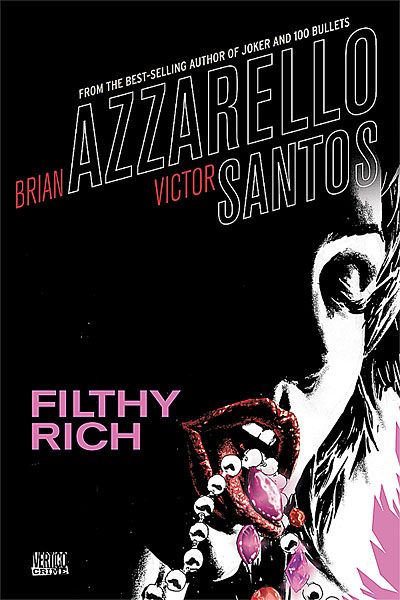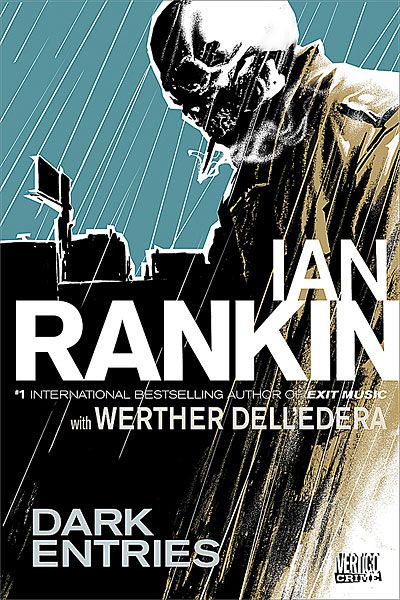by Brian Azzarello and Victor Santos
Vertigo, 200 pages, $19.99
by Ian Rankin and Werther Dell'edera
Vertigo, 216 pages, $19.99.
You've gotta give DC credit, they're constantly trying new things. Sure, a lot of their publishing experiments embarrassingly fall on the floor, but the very fact that they have such a lengthy track record of failed imprints -- Minx, Helix, Piranha, Paradox Press -- says something about the company's willingness to branch out. They're restless in their attempt to find new audiences.
Thus we now have Vertigo Crime, a sub-imprint of the current Vertigo line, consisting of stand-alone graphic novels filled with guns, girls and as much noir as you can possibly stand. The first two entries in the line -- Filthy Rich and Dark Entries -- will be out in stores this month (Aug. 19 and 25 to be exact). How do they hold up? Read on to find out.
Filthy Rich is written by Brian Azzarello, and if there's one man who can be said to be the driving force behind this new line, it's him. Sure, things like Ed Brubaker and Sean Phillips' Criminal series for Marvel and Darwyn Cooke's new Parker book were probably influences as well, but the success of the recently completed modern noir series 100 Bullets no doubt served as the primary inspiration for Vertigo Crime.
Sadly, Filthy Rich is no 100 Bullets. In some ways it reminded me more of Loveless -- a serviceable, even mildly enjoyable comic that fails to generate any real sparks. The story is, as always, a rather familiar tale involving a big, violent lug of an ex-football player named Richard "Junk" Junkin. Not having much luck in his current job as a car salesman, Junk takes on the job of bodyguard for his boss' spoiled, socialite daughter. No prizes for guessing she's a troublesome minx who makes Junk's heart go all thumpa-thumpa .
It's not that there weren't any surprises in Filthy Rich that bothered me as much as the book's inconsistent tone and inability to develop any pathos for its characters. I didn't really care about Junk's sob story life and the daughter, Vicki, is so thinly portrayed that she comes off as little more than sex in high heels. There's no room for nuance here.
What's more, Azzarello's prose comes off as a bit awkward at times, as though it wasn't proofread enough. The transitions between panels seem weirdly off as though an extra segue or two is needed. ("But then like in every one of these stories, something came out of nowhere and fucked it all up. So the Prince? / My life ended three years ago.")
Meanwhile, artist Victor Santos' work here is a bit too heavily influenced by Frank Miller's Sin City, meaning the book is all shadows, spot blacks and heavy inks. That wouldn't necessarily be a problem (though it does make the book feel derivative) except that he can't seem to stay on model with his characters. Junk's chin keeps changing shape and Vicki's head seems squashed at times only to pop back into shape later. The fact he draws his characters with disproportionately large heads doesn't really sit well with me either.
The second entry in Vertigo's crime line is Dark Entries. This graphic novel is very obviously designed to appeal to the more "traditional" Vertigo fan to some extent, since it is essentially a Hellblazer spin-off starring John Constantine and doesn''t really fit easily within the crime genre. There are no heists pulled or gunfights here.
So why is this a Vertigo Crime book instead of being contained within Hellblazer proper? Because it's written by the very popular crime novelist Ian Rankin, best known for the Inspector Rebus series. DC is obviously betting that the name will be a big draw for casual readers and non-comics folk, hence the fact that Rankin's name is the largest thing on the front cover, bigger than even the book's title.
But I digress. In Dark Entries Constantine is hired by a shady reality TV producer who is having supernatural difficulties with his latest production, a "Big Brother"-type show where the contestants have to stay in a haunted house. Problem is, it looks like the house might really be haunted, and the producers want Constantine to investigate by becoming a contestant on the show.
Of course, it's never that simple and if I tell you that someone is trying to rook old John, you'd probably say, "So what else is new?" I didn't mind the big reveal halfway through the book, but I can't say I was terribly surprised by it.
Rankin manages to get some clever ideas out of his initial concept, and there are some good (if obvious) jokes to be had at the expense of reality TV, but the basic plot also has some holes. Without trying to spoil things, why, for instance, would the producers need actual cameras and microphones? It doesn't feel like Rankin has thought through this supernatural world he's created enough.
As for artist Werther Dell'edera, he's also big on the spot blacks, though his style is a little sketchier and rougher than Santos'.That can make it hard at times to suss out certain sequences.
Despite these problems, I confess I found myself engrossed with Entries while reading it, and gobbled the whole thing down early one morning while folding laundry. Faults aside, it's a decent little Hellblazer tale that will likely entertain fans of the series. Whether it's $20 good is something those fans will have to decide on their own.
Honestly, I hope the Vertigo Crime line does well. I'd really like to see more crime comics by big-name authors on the stands. But then I also wanted to see more of the kind of books that Minx, Helix and Paradox offered. And I don't see anything here in these first two books that suggest that Vertigo Crime will last any longer than those imprints did.



